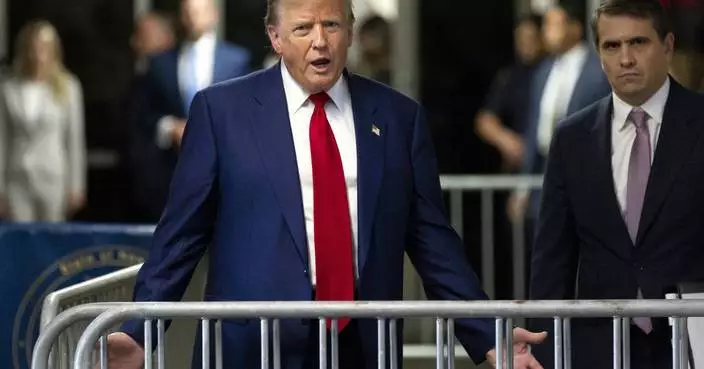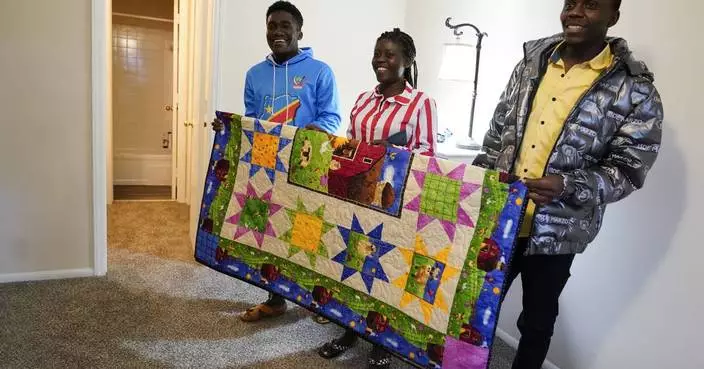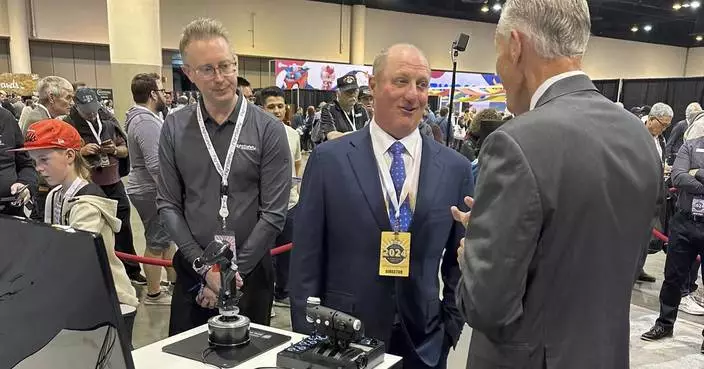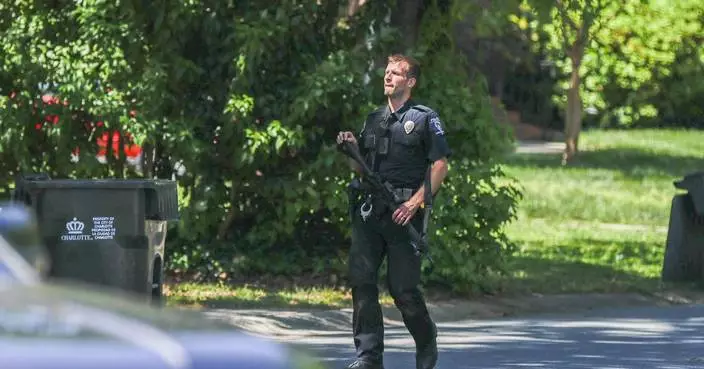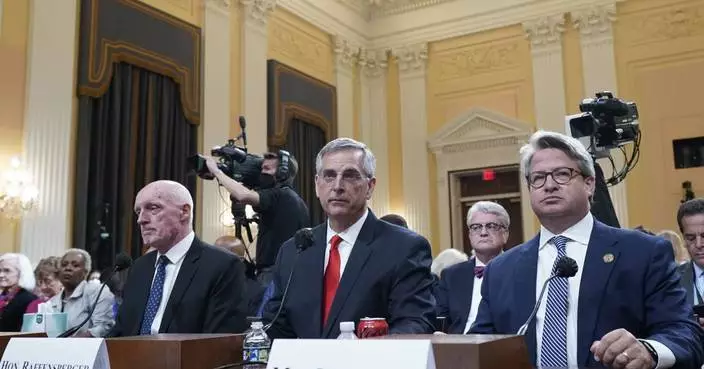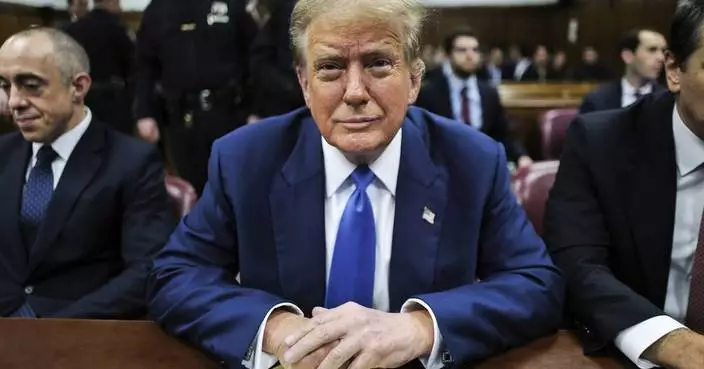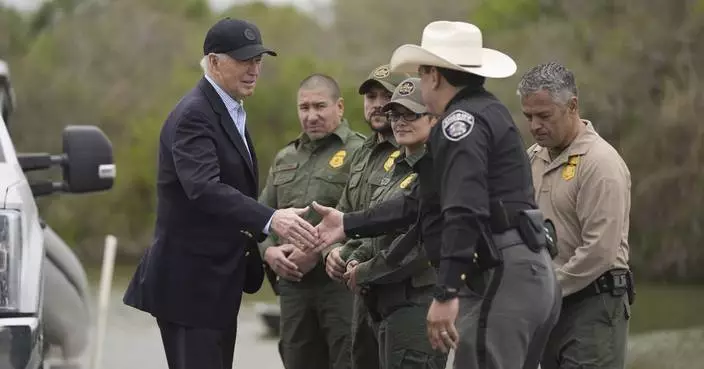President Donald Trump got the history-making handshake he wanted with North Korea's Kim Jong Un. Now, with the smiling snapshot a part of history, new details are emerging about the bizarre behind-the-scenes negotiations that led up to the summit — and about the president's post-summit frustrations with how it's being portrayed.
Setting up the Singapore meeting was no easy feat for the technically still-warring heads of state, requiring planners to accommodate confounding requests and paranoia. But neither has it been easy for Trump to sell the plan to a doubting class of experts, allies and the media. He's chafing at the skepticism swirling about the nuclear accord that he wants to define his legacy.

FILE - In this Tuesday, June 12, 2018, file photo, North Korea leader Kim Jong Un and U.S. President Donald Trump prepare to sign a document at the Capella resort on Sentosa Island in Singapore. At the ceremony, a gloved North Korean official inspected Kim’s chair and the black felt-tipped pen bearing Trump’s signature in gold that was positioned for Kim’s use. At the last minute, Kim’s sister, Kim Yo-jong, far left, provided a pen of her own for his use. (AP Photo/Evan Vucci, File)
Scenes from inside the summit:
"ALIEN" TERRITORY?
Like talking with "aliens." Sitting at tables at the luxurious Capella Hotel in Singapore or in the sparse Demilitarized Zone on the Korean Peninsula, that's how U.S. officials involved in negotiations with their North Korean counterparts described their conversations ahead of the summit.
The North Koreans had never before participated in an event of the sort, were unfamiliar with notions of press access and deeply afraid about both espionage and assassination. The North Korean logistics teams struck the Americans as organized, detail-oriented and mission-focused, said one official involved in the planning. There were also a number of women involved in senior roles, surprising to the U.S. side.
On the day before the summit, U.S. and North Korean officials met throughout the day in Singapore to hash out areas of agreement for what became the joint statement issued by the two leaders on Tuesday. The U.S. team wanted to send in an official photographer to capture the moment for history — a manifestation of the White House's desire to turn the summit into an international media event — but the North Koreans balked.
"How do we know she's not a spy?" protested the North Koreans. They eventually agreed the photographer could attend, said an official familiar with the discussions with the North Koreans who wasn't authorized to discuss it and insisted on anonymity.
Similar worries had come up earlier in the talks when the Korean delegation voiced concerns that cameras belonging to the press could be concealed weapons.
THE TRUST GAP
There was hardly trust on the U.S. side either. Kim, after all, is accused by the U.S. of ordering the murder of his half brother with a nerve agent last year.
From the first logistical talks in Singapore, it was clear to U.S. officials that overcoming the security trust gap was among the most significant hurdles to getting the two leaders into the same room.
For every person the White House wanted to put in the room for the meetings, the North wanted to know how they would know the person was not there to spy on the proceedings or harm Kim.
U.S. officials credited the Singaporean government for helping to prevent the mistrust from sinking the summit.
Checkpoints were jointly patrolled by U.S., North Korean, and Singaporean officials, with some journalists on site required to undergo separate security sweeps by each of the three parties. U.S. officials agreed to cap the number of U.S. government officials they allowed onto the luxury summit property to match the far smaller North Korean delegation.
It left all but the most senior American negotiators, including many subject matter experts, monitoring the proceedings via television and emailed updates from the president's hotel, a 20-minute drive away.
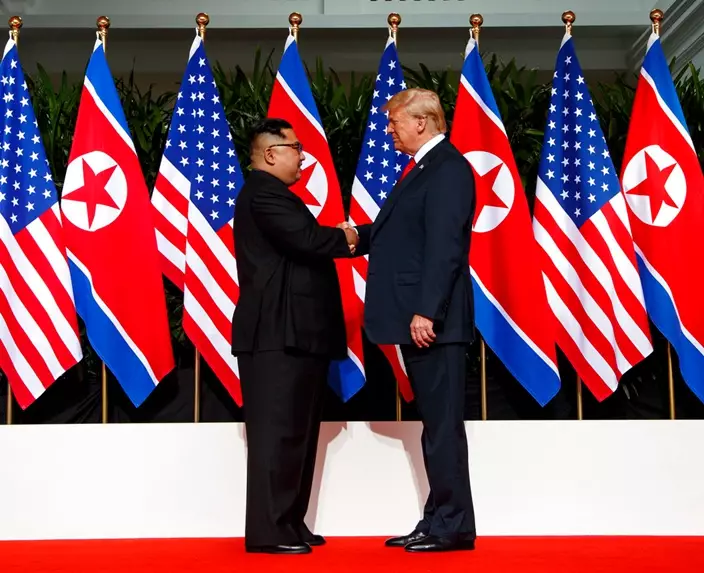
FILE - In this Tuesday, June 12, 2018, file photo, North Korean leader Kim Jong Un, left, and U.S. President Donald Trump shake hands prior to their meeting on Sentosa Island in Singapore. Trump got the history-making handshake he wanted with Kim. Now that the snapshot is a part of history, new details are emerging about the behind-the-scenes negotiations that led up to the summit. (AP Photo/Evan Vucci, File)
OLD HABITS DIE HARD
At a formal signing ceremony Tuesday afternoon, a gloved North Korean official inspected Kim's chair and the black felt-tipped pen bearing Trump's signature in gold that was positioned for Kim's use.
At the last minute, Kim's sister, Kim Yo-jong, who was standing to his side, provided a pen of her own for his use.
The U.S.-supplied pen was later retrieved, unused, by a White House staffer.
EQUAL PARTNERS
Throughout the summit preparations, U.S. officials described the North Koreans as focused on ensuring they were not the junior partner in the talks.
In a symbolic concession, the DPRK (Democratic People's Republic of Korea) was listed above the U.S. in the official summit logo on credentials for the summit. The White House also agreed to limit the number of journalists allowed to cover some events to mirror the North Korean contingent of state-run media.
Still, Trump appeared to be in the driver's seat, clapping Kim on the back and directing over to their interpreters to start their one-on-one meeting. The U.S. president also signaled for reporters in the room to be escorted out — after both took questions from the journalists.
FRUSTRATION FACTOR
On the final day before the summit, officials at the White House National Security Council back in Washington grew incensed over a New York Times report suggesting that "science is unwelcome" in Trump's administration and that the U.S. negotiating team was devoid of nuclear physicists. So the White House issued a directive to Secretary of State Mike Pompeo: He would go in front of cameras in Singapore and call out the newspaper by name, an official familiar with the instruction said. Pompeo complied.
"Before discussing the summit, I want to address a report in The New York Times," Pompeo opened. "Any suggestion that the United States somehow lacks the technical expertise across government or lacks it on the ground here in Singapore is mistaken."
Now that he's back home, Trump has been fuming privately and publicly over the skeptical news coverage about his signed agreement with Kim. Never steeped in details or history, the president feels he has made ground-breaking progress, as evidenced by his grand statements telling the world to "sleep well." Back in DC, in a terrible mood, he is frustrated by all the questions about the fine print.
Trump has been calling lawmakers to express enthusiasm for the agreement — but also complaining that he has not had more robust support from GOP lawmakers, said a person with knowledge of the calls, who spoke on condition of anonymity to share internal conversations. While the president calls the summit a "first step," with more meetings sure to come, he also has been arguing that he has already done more than his predecessor, President Barack Obama.
NEW YORK (AP) — Donald Trump’s New York criminal trial is full of terms you don’t typically hear in a courtroom.
Centering on allegations Trump falsified his company’s records to conceal the nature of hush money reimbursements, it's the first ever criminal trial of a former U.S. president and the first of Trump’s four indictments to go to trial. It also has some unique terminology.
Here are some examples:
DEFINITION: According to Merriam-Webster, it's money paid so that someone will keep information secret. In other words, money that a person pays someone to hush up something.
EXAMPLE: Three payments that prosecutors say were made on Trump's behalf to bury marital infidelity claims during his 2016 presidential campaign. They are the National Enquirer's $30,000 payment to a Trump Tower doorman and $150,000 payment to former Playboy model Karen McDougal, and the $130,000 that Trump’s then-lawyer and fixer Michael Cohen arranged to pay porn actor Stormy Daniels.
Paying hush money isn't illegal on its own, but authorities say the payments made to suppress stories about Trump amounted to illegal campaign contributions. Cohen pleaded guilty in 2018 to a federal campaign violation, among other unrelated crimes. The National Enquirer's parent company, American Media Inc., entered into a nonprosecution agreement in exchange for its cooperation with prosecutors. The Federal Election Commission fined the company $187,500, declaring that the McDougal deal was a “prohibited corporate in-kind contribution.”
DEFINITION: As prosecutor Matthew Colangelo told jurors in his opening statement, “catch-and-kill” is when a tabloid newspaper such as the National Enquirer “buys up damaging information about someone, demands that the source sign a nondisclosure agreement to prevent them from taking that information or that story anywhere else, and then the tabloid declines to publish the story to prevent it from ever seeing the light of day.” A nondisclosure agreement is also known as a confidentiality agreement.
EXAMPLE: Tabloids typically pay sources and story subjects for information they end up publishing. But sometimes they pay for stories to prevent their publication. Former National Enquirer publisher David Pecker testified that he agreed, at a Trump Tower meeting in August 2015, to be the “eyes and ears” of Trump's 2016 presidential campaign. Under the arrangement, Pecker said he would notify Cohen of women who were seeking to sell stories about Trump so Trump's team could “take them off the market or kill them in some manner.”
Pecker testified that he had suppressed stories about other celebrities and politicians over the years using the same “catch and kill” methods, including actor and ex-California Gov. Arnold Schwarzenegger and golfer Tiger Woods. Pecker said he sometimes suppressed stories simply to help a friend or further his business interests, but often he did so to leverage the story subject into doing something else, like agreeing to an interview or posing for a magazine cover.
DEFINITION: This is the criminal charge that's being decided at Trump's New York trial. He is charged with 34 counts of falsifying business records in the first degree. It is a felony punishable by up to four years in prison, though there is no guarantee Trump would be sentenced to any time if convicted. He has pleaded not guilty.
Under New York law, a person is guilty of falsifying business records in the first degree when he makes or causes a false entry to be made in a company's business records and does so with an intent to defraud, including intent to commit or hide another crime.
EXAMPLE: Prosecutors allege Trump misrepresented payments to Cohen in Trump's company records as legal fees when they were actually a reimbursement for the $130,000 that Cohen arranged to pay Daniels. The records at issue include general ledger entries, invoices and checks. Prosecutors argue Trump's actions were a way of hiding the hush money scheme and concealing other crimes arising from it, including alleged election law violations. Trump denies the allegations. His lawyers have said the payments to Cohen were for legitimate legal expenses.
DEFINITION: Trump isn’t charged with the crime of conspiracy, but prosecutors at his New York trial have used the term repeatedly to describe his “eyes and ears” agreement with Pecker and the hush money arrangements that ensued.
According to Merriam-Webster, conspiring involves joining “in a secret agreement to do an unlawful or wrongful act or an act which becomes unlawful as a result of the secret agreement.” Under New York law, a conspiracy involves at least two people acting with intent to commit a crime.
EXAMPLE: Colangelo, the prosecutor, said in his opening statement that Trump's trial involves “an illegal conspiracy to undermine the integrity of a presidential election.” To convict Trump of felony falsifying business records, prosecutors must show that he had intent to commit another crime. Assistant District Attorney Joshua Steinglass said in court that one of the crimes Trump intended to commit was a violation of a New York election law — a misdemeanor involving a conspiracy to promote or prevent an election.
DEFINITION: Any attempt to alter the outcome of an election through nefarious means, such as fraud, voter intimidation or efforts to overturn the outcome of a race.
EXAMPLE: Prosecutors allege the hush money scheme amounted to election interference because it involved a concerted effort to hide important information from voters in order to boost Trump's chances in the 2016 race.
Not only was the National Enquirer acting as the “eyes and ears” of Trump's campaign, identifying negative stories so they could be suppressed, Pecker testified that the tabloid, at Cohen’s behest, printed stories that tarred Trump’s opponents. It also published stories that boosted Trump's image.
It’s a different kind of election interference allegation from what Trump is charged with in his Washington and Georgia cases, where he’s accused of attempting to subvert his 2020 election loss to Democrat Joe Biden. Meanwhile, Trump claims that being put on trial while he’s campaigning as this year’s presumptive Republican nominee is its own form of election interference.
DEFINITION: Generally speaking, a gag order is “a judicial ruling barring public disclosure or discussion (as by the press) of information related to a case,” according to Merriam-Webster. In Trump’s case, it's known as an Order Restricting Extrajudicial Statements, with extrajudicial meaning outside of court.
EXAMPLE: Judge Juan M. Merchan, acting on a request from prosecutors, imposed a limited gag order on Trump on March 26. It bars the former president from making or directing other people to make public statements on his behalf about potential witnesses regarding their participation in the case. It also prohibits comments about jurors, prosecutors other than District Attorney Alvin Bragg, and any statements meant to interfere with or harass the court’s staff, prosecution team or their families.
Merchan expanded the order on April 1, barring Trump from commenting about his family or Bragg’s family. The change came after Trump assailed the judge’s daughter and made false claims about her on social media.
Last Tuesday, Trump was assessed a $9,000 fine — $1,000 for each of nine separate gag order violations that the judge identified. Prosecutors later requested an additional $4,000 penalty for what they said were additional breaches of the order.
Merchan lamented that $1,000 per violation is the maximum fine allowed by law and floated the possibility of jailing Trump if he continues to run afoul of the gag order, an unprecedented outcome for a former American president.
Trump’s lawyers insist he needs leeway to respond to criticism, including from witnesses like Cohen and Daniels, and that the gag order impedes his ability to answer questions and defend himself amid a crush of media coverage of his case and his candidacy.
Follow Sisak at x.com/mikesisak and send confidential tips by visiting https://www.ap.org/tips
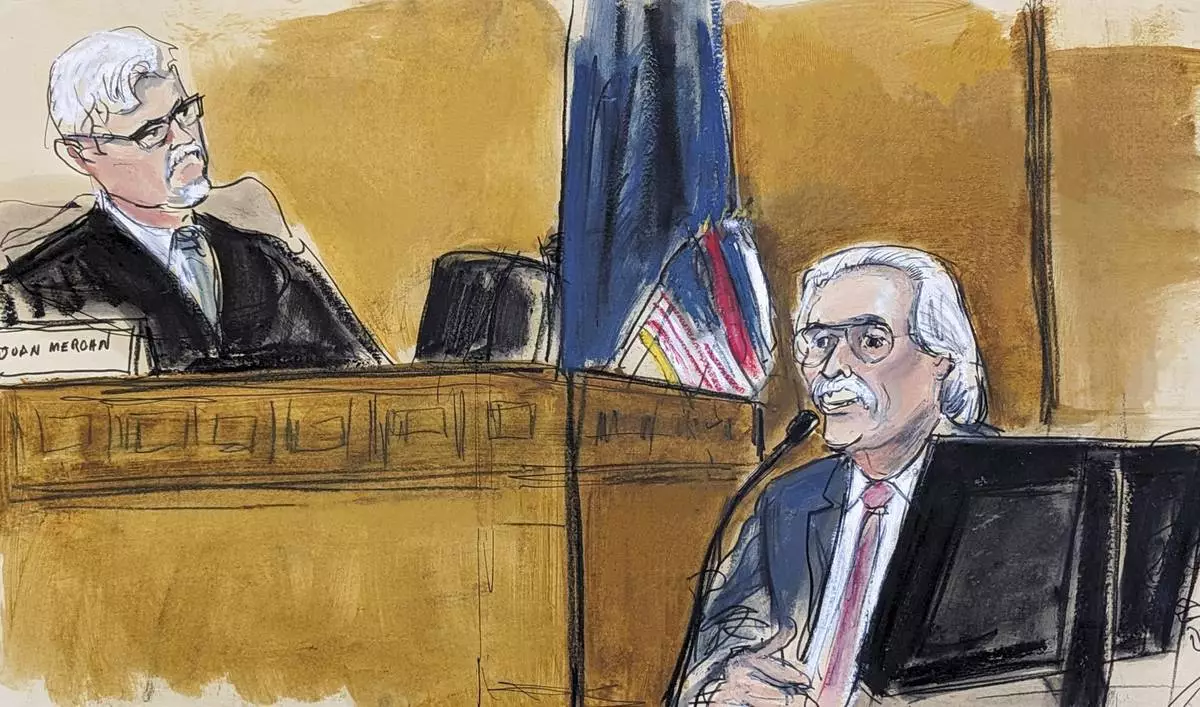
Judge Juan Merchan, left, listens as David Pecker testifies on the witness stand in Manhattan criminal court, Friday, April 26, 2024, in New York. (Elizabeth Williams via AP)
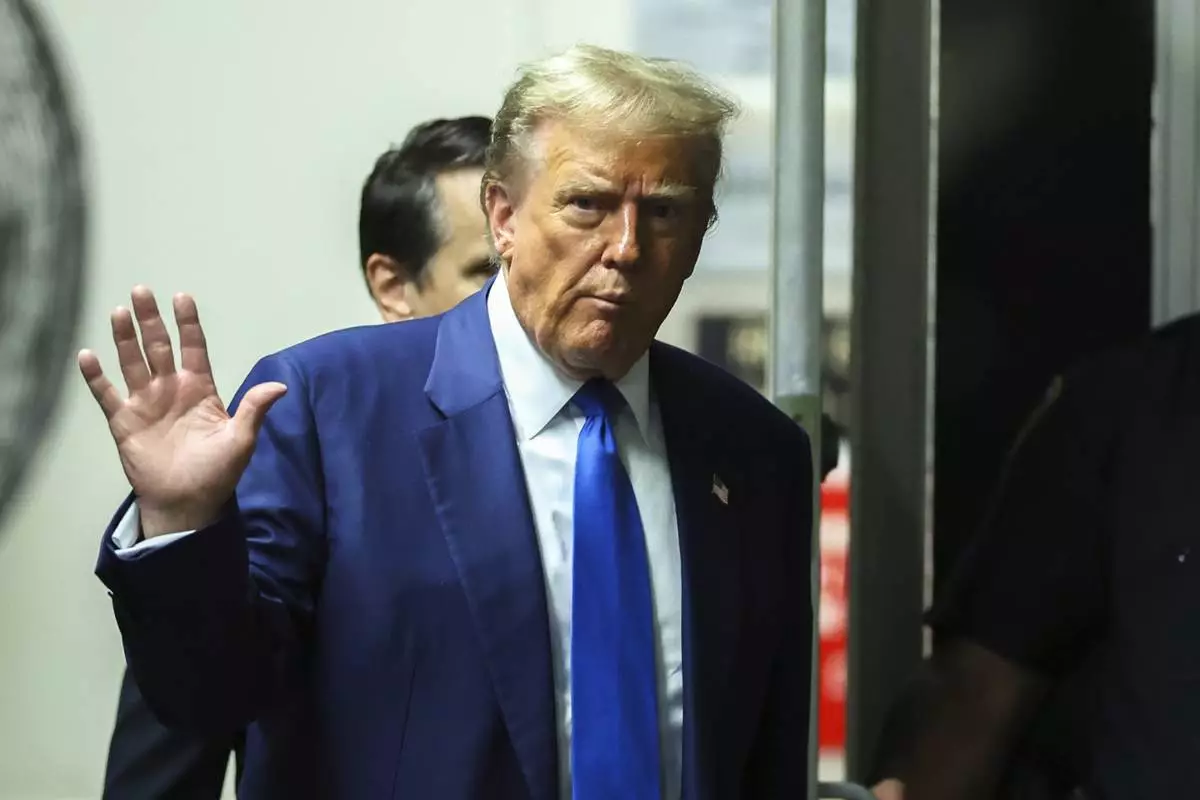
Former President Donald Trump returns to the courtroom following a break in his trial at Manhattan criminal court in New York, on Friday, May 3, 2024. (Charly Triballeau/Pool Photo via AP)
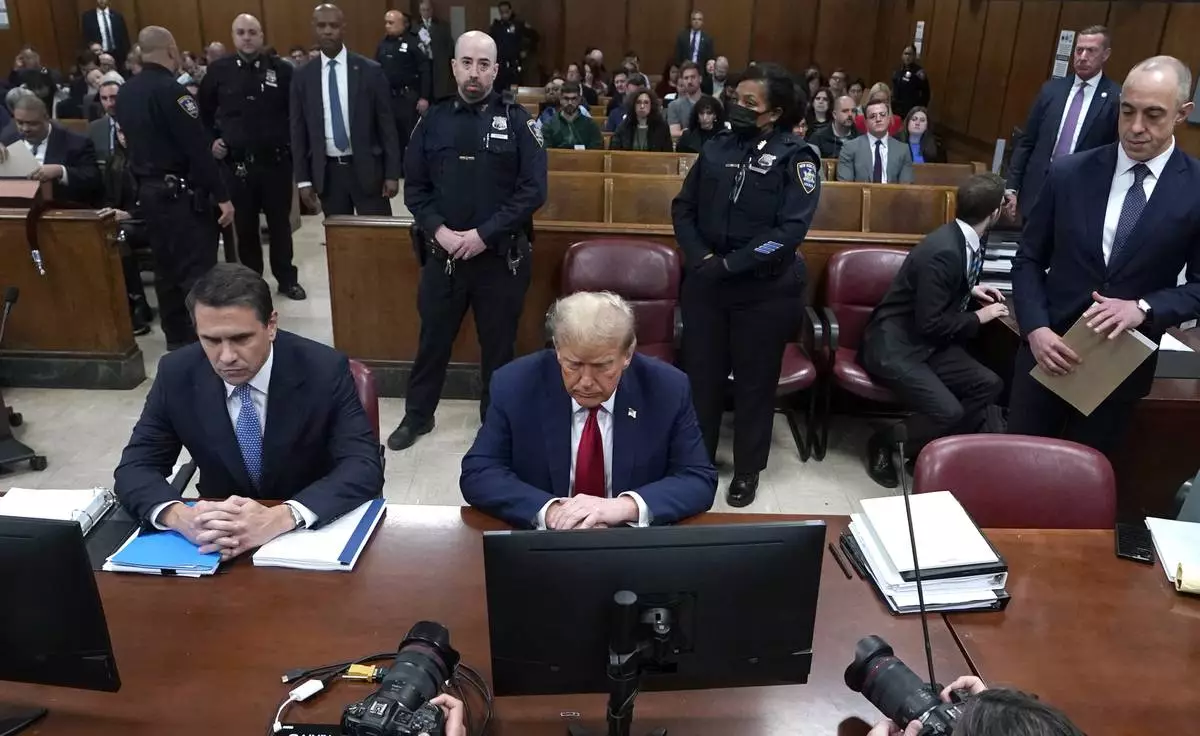
FILE - Former President Donald Trump, with lawyer Todd Blanche, left, attends trial in New York City, April 23, 2024. Trump's New York criminal trial is full of terms you don't typically hear in a courtroom. Centering on allegations Trump falsified his company's records to conceal the nature of hush money reimbursements, it's the first ever criminal trial of a former president and the first of Trump's four indictments to go to trial. (Timothy A. Clary/Pool via AP, File)








